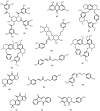Latin American Plants against Microorganisms
- PMID: 38068631
- PMCID: PMC10708099
- DOI: 10.3390/plants12233997
Latin American Plants against Microorganisms
Abstract
The constant emergence of severe health threats, such as antibacterial resistance or highly transmissible viruses, necessitates the investigation of novel therapeutic approaches for discovering and developing new antimicrobials, which will be critical in combating resistance and ensuring available options. Due to the richness and structural variety of natural compounds, techniques centered on obtaining novel active principles from natural sources have yielded promising results. This review describes natural products and extracts from Latin America with antimicrobial activity against multidrug-resistant strains, as well as classes and subclasses of plant secondary metabolites with antimicrobial activity and the structures of promising compounds for combating drug-resistant pathogenic microbes. The main mechanisms of action of the plant antimicrobial compounds found in medicinal plants are discussed, and extracts of plants with activity against pathogenic fungi and antiviral properties and their possible mechanisms of action are also summarized. For example, the secondary metabolites obtained from Isatis indigotica that show activity against SARS-CoV are aloe-emodin, β-sitosterol, hesperetin, indigo, and sinigrin. The structures of the plant antimicrobial compounds found in medicinal plants from Latin America are discussed. Most relevant studies, reviewed in the present work, have focused on evaluating different types of extracts with several classes and subclasses of secondary metabolites with antimicrobial activity. More studies on structure-activity relationships are needed.
Keywords: Latin American plants; bacteria; fungi; microorganisms; virus.
Conflict of interest statement
The authors declare no conflict of interest.
Figures








References
Publication types
LinkOut - more resources
Full Text Sources
Miscellaneous

